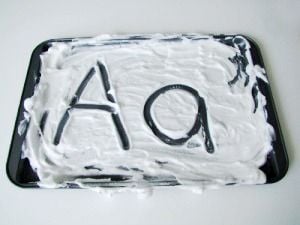ABC! It’s as easy as 1 2 3! Okay, maybe teaching your child the alphabet isn’t that easy, but it can be fun! Giving your child opportunities to participate in multi-sensory alphabet activities will get them started on their journey to reading. Before reading can begin, children need to learn letter shapes, names of letters, and letter sounds.
Is your child ready to learn the alphabet? Children develop at different rates, especially when it comes to learning. Just because your child turned a certain age doesn’t mean your child is developmentally ready to learn the alphabet. If your child shows a strong interest in letters, words, and books, they may be prepared to begin learning the sounds and letters of the alphabet. Your child may start showing interest in learning the alphabet around the age of two, but don’t worry if your child isn’t ready yet. Rushing your child will lead to frustration and lower their motivation to learn.
The Importance of Multi-Sensory Learning
Every child learns differently! Some people learn best by touching objects, while others prefer watching and imitating. Some people learn best by moving or listening to verbal instructions. Combining these strategies is called multi-sensory learning.
Multi-sensory activities are a great way to learn and practice the alphabet. Participating in multi-sensory activities is important for remembering new information. Using multiple senses during a learning activity will give your child a better chance of remembering things later and connecting new knowledge to something they already know.1
Tips to Effectively Teach Your Child the Alphabet
Here are some of my favorite ways to teach the alphabet to little ones. Many of these activities involve your child using their listening skills, movement, vision, and touch.
1. Choose Easier Sounds to Learn

There are many sequences for introducing letters and sounds, but you may want to consider what sounds your child can already pronounce. What sounds are your child the most familiar with? You may also want to start with sounds heard in a letter’s name (for example, the sound for the letter Z is heard in the letter’s name), and the uppercase and lowercase look similar. Flashcards are a great way to introduce a new letter and sound to your little one.
2. Tracing Letters!
Buy Here
Squirt shaving cream on a table and have your child say and write letters in the cream. Your child can easily smooth it out to erase it and start again! Sand trays can also be used for this purpose.
3. Use Pipe Cleaners

Pipe cleaners are a fun way to practice letter formation and fine motor practice!
4. Sing Songs About the Alphabet
Sing songs that combine letters, sounds, and movement. Heidi Songs (here) has catchy songs for learning upper- and lower-case alphabet formation.
5. Sandpaper Letters

Tactile letters, such as these sandpaper letters, provide kinesthetic feedback many children need to reinforce letter recognition. You can even make your own by gluing items on a letter!
6. Use Cars With a Letter Racetrack

Combine your child’s love for cars with this fun learning activity. First, create a large letter on the floor with masking tape or use a template. Next, let your child trace the letter by driving toy cars on the lines. Add in extra fun by pretending that your car makes the letter sound.
7. Set up an Animal Parade
Does your child love animals? Create a large letter on the floor with masking tape. Your child can walk or swim a toy animal over the letter, saying the letter sound as they walk.
8. Tongs and Pom-Poms

Your child can use tongs to pick up pom-poms or other small items and place them on a letter as they say the letter’s sound.
9. Letter Construction Set

This letter construction set can help your child practice letter recognition and pre-handwriting skills by snapping together color-coded pieces to build uppercase and lowercase letters. This activity also helps develop fine motor skills!
10. Alphabet Lacing Set

If you teach your child the letters in their name, this alphabet lacing set incorporates fine motor skills with letter recognition. It’s also fun! Your child can wear it as a necklace and practice saying the letters in order.
11. Read Books Together

Reading alphabet books is another great way to learn the alphabet. Here are a few that will engage your child.
- Eating the Alphabet: Fruits & Vegetables from A to Z by Lois Ehlert
- ABC & 123 Learning Songs by Scarlett Wing
- Peek-a-Flap ABC by Jaye Garnett
- Chicka Chicka Boom Boom by Bill Martin Jr. and John Archambault
12. Make Your Own Alphabet Book!
You can personalize the ABCs to help your child process and retain their learning. Create your own ABC book by having your child write the uppercase and lowercase letters and draw and/or cut and glue pictures of things that start with each letter. Staple the pages together, and you have your very own alphabet book! You can also use this resource to find fun crafts and activities for each letter.
Learning the alphabet is foundational for reading and writing. If your young child is interested in learning alphabet letters, you may want to start incorporating some of these activities into your days! Alphabet practice can be fun and help create a lifelong love for letters and words.

































